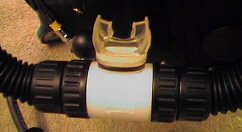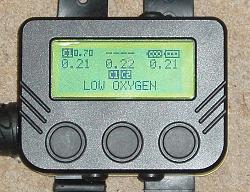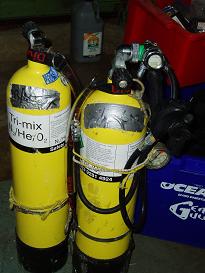| ◊ | Harness improvements. It must
be possible to make it simpler. You need to wash it so you take off all the
hoses and clean them down in the sink and then it's time for the counterlungs.
These were fitted with a sewing machine so it's time to fit screw on covers
to the first stages and put the entire thing in the bath. This is silly so see
the modifications section. |
| ◊ | Better computer displays. The Classic was far too
clunky and could do a better range of warnings. People have died because they
didn't switch them on, which you must admit isn't APD's fault, but auto switch
on when immersed is hardly complex electronics. Forgetting to switch up a
set-point is also a serious problem and needs only a depth sensor (even just a
pressure switch) to beep at you until you do something about it. The later
Vision handset is much better. |
| ◊ | The big breathing hose connectors catch you out as a
novice as you can start to unscrew the wrong part and it is very hard to
retighten them if you slacken it. On a unit this expensive any special tools
required to fix basic problems should be in the box. It's only a bit of tube
with some studs in it. |
| ◊ | Perhaps a revised glue on the scrubber lid might be
worth considering. I like solvent glues that effectively weld two pieces of
plastic into one solid lump. They do cause distortion but that can be managed.
Things don't fall apart then. Again I notice a design change on the
Vision. |
| ◊ | The AutoAir is a joke but it is so designed in
that you are effectively stuck with it. I will very seriously look into fixing
this with something that does not need babying and that is suitable to hand
off. As it stands the Inspiration is effectively designed for solo diving. Its
breathe-the-wing feature worries me. It will let you breathe
in from the wing automatically if the tank runs out and then you exhale into
the water. If you ever get to that point it means you have just discarded a
lung full of buoyancy. I would far rather it went hard in my mouth and gave me
the choice. |
| ◊ | I was a little disappointed with the weight. With my
additions it tips the scales at 30kgms but I suppose that is to be expected.
This is including two 4Kg tanks, about 3Kgs of Sofnolime and a couple of kgs of
gas. Then there are two first stages, gauges, computers, hosing and such. I
expected it to be less but it's built to survive and I can't complain at that.
Like all AP stuff it won't break with a bit of real world use. |














 Oxygen regulator
Oxygen regulator The Bob-o-matic Auto Diluent Valve.
The Bob-o-matic Auto Diluent Valve. A Metalsub clip and a 1.5L Argon bottle.
A Metalsub clip and a 1.5L Argon bottle.



 Vision Electronics
Vision Electronics
 Removable counter-lungs
Removable counter-lungs Custom Diver's handle
Custom Diver's handle Fourth Cell
Fourth Cell Stages
Stages Tools
Tools